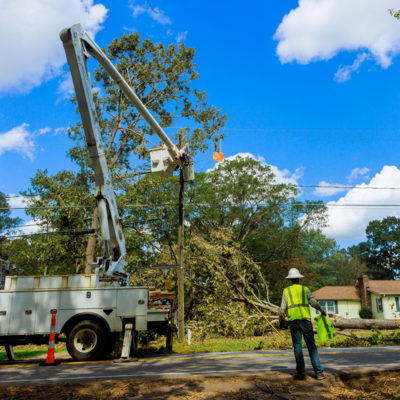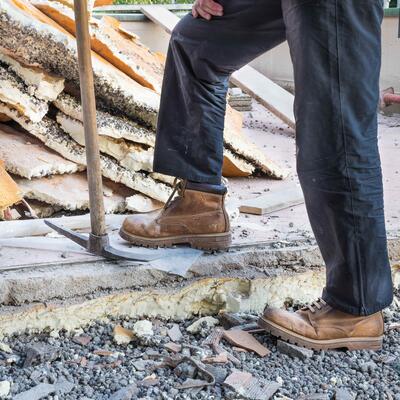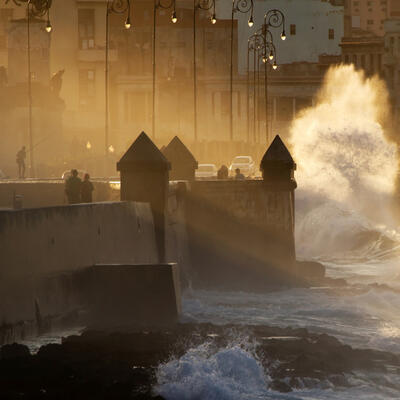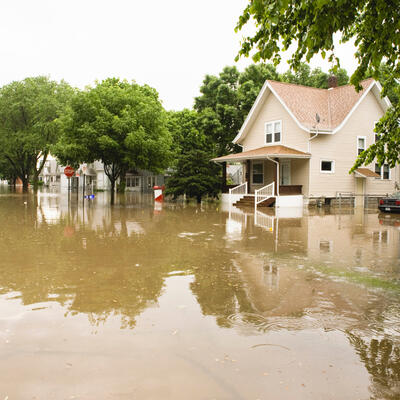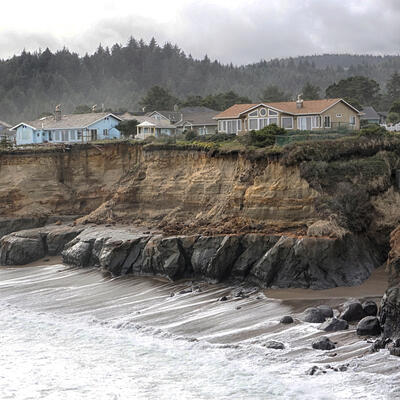
Managed Retreat: When Climate Hits Home
Guests

Sam Turken
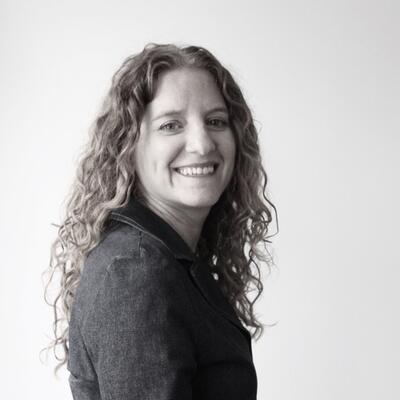
Amy Chester

Kia Javanmardian
Summary
When it comes to rising seas and other climate threats, how do we figure out when to stay and when to go?
The concept of managed retreat – essentially abandoning homes or towns – is unpopular, but it’s gaining momentum, particularly in places facing increased climate disruption such as floods and wildfire.
Southeast Virginia currently experiences the fastest rate of sea level rise on the Atlantic coast. And that’s only projected to accelerate over the next several decades – to the point where neighborhoods could be lost to flooding.
As Sam Turken reports, the common response to the rising waters in Southeast Virginia has been to elevate homes, install flood pumps, and heighten sea walls. But in some cases, cities are already telling the sea, “Hey, you can have this land.” Turken covered the complexities of voluntary buyout programs and the equity issues they raise in a series for WHRO in Norfolk, Virginia, funded by the Pulitzer Center as part of their Connected Coastlines Reporting Initiative.
Turken reports that local governments have limited funding to put toward buyouts, and even with growing flooding risks, many people are reluctant to take the offers.
“People love their neighborhoods, and even if you may be trying to help them and get them out of harm's way, you're stripping them from something that is really part of their heart,” Turken says. He says you also have to consider where people go if they take a buyout, at a time when housing is in short supply and prices are on the rise.
“Unless we build more affordable housing in the decades to come to prepare for something like this – affordable housing in safe areas – we’re gonna have a lot of people who, even if they're leaving, they’re stranded, because they have nowhere else to go.”
Insurance and reinsurance companies were among the earliest corporations to ring the alarm on climate. They know the damage and risk numbers better than anyone else. Kia Javanmardian is a senior partner at McKinsey & Company where his focus includes advising insurance companies on climate risk.
He says while insurance companies typically have the ability to reprice every year, some have moved away from certain markets entirely, driving up prices. He says that’s one factor to consider as climate disruption accelerates.
“There are just some places where, despite what you build a building from, how high you put it above the ground, it still might not make sense to actually be building there,” Javanmardian says.
While some places look to retreat, other cities are doubling down, with investments in more resilient and flexible design. Amy Chester is managing director of Rebuild By Design, a firm working to help cities and communities build climate resilience.
During Hurricane Sandy in 2012, the southern tip of Manhattan was without power, shutting down the New York Stock Exchange and causing patients to be evacuated from hospitals. Chester says Sandy revealed that more needed to be done to respond to and plan for future climate threats.
“Since Hurricane Sandy we've been focused on our shorelines to ensure that when we have three to six feet of sea level rise in New York City and increased storms, that the storm surge doesn't wipe away communities. What Hurricane Ida showed us is that every single community in New York City is vulnerable,” she says.
Chester says investments in climate resilience have to include community involvement and a focus on equity to serve their communities in the best way possible. And there’s no time to waste.
“Communities are suffering and we all collectively have a responsibility to do something about it,” she says. “We’re gonna have to decide together: which are the neighborhoods that we want to fortify and where are the neighborhoods that we want to retreat? And if we retreat, where are our community members gonna go, and how do we ensure that when community members move upland that they're not further gentrifying communities?”
Related Links:
At A Crossroads
Rebuild By Design
Full Transcript
Greg Dalton: This is Climate One. I’m Greg Dalton. I’d like to hear your comments on the show, topics we should cover, and guest suggestions. You can reach me at greg@climateone.org. As climate threats intensify and sea levels rise, coastal communities are some of the first to face hard questions about relocating.
Kia Javanmardian: There are just some places where despite what you build a building from, how high you put it above the ground, it still might not make sense to actually be building there.
Greg Dalton: Some cities are doubling down, with investments in more resilient and flexible design:
A.R. Siders: “For every dollar we spend on managed retreat, the estimates are that you save four to eight dollars. So that’s a pretty incredible return on investment financially in terms of avoiding those losses.”
Greg Dalton: But even voluntary managed retreat raises a slew of questions about equity:
Amy Chester: If we retreat, where our community members gonna go and how do we ensure that when community members move upland that they're not further gentrifying communities.
Greg Dalton: When Climate Hits Home. Up next on Climate One.
Greg Dalton: When it comes to rising seas and other climate threats, how do we figure out when to stay and when to go? This is Climate One, I’m Greg Dalton.
Greg Dalton: The concept of managed retreat--essentially abandoning homes or towns--is unpopular, but it’s gaining momentum, particularly in places facing increased climate disruption such as flood and wildfire. Axios recently highlighted how several big corporations are responding: a healthcare facility on the Charleston peninsula announced a $500 million plan to move inland after repeated bouts of flooding; similarly, both Hewlett Packard and Spirit Airlines have announced plans to move operations inland in Texas and Florida, respectively, due to flooding and hurricane risks.
Greg Dalton: Southeast Virginia currently experiences the fastest rate of sea level rise on the Atlantic coast. And that’s only projected to accelerate over the next several decades -- to the point where neighborhoods could be lost to flooding. Sam Turken is a reporter who recently produced a series at WHRO in Norfolk, Virginia, funded by the Pulitzer Center as part of their Connected Coastlines Reporting Initiative. We’re featuring two of his stories today on Climate One. As Sam Turken reports, the common response to the rising waters in Southeast Virginia has been to elevate homes, install flood pumps, and heighten sea walls. But in some cases, cities are already telling the sea, “Hey, you can have this land.”
[START PLAYBACK]
Sam Turken: There is something unique about the Fernwood Farms neighborhood in Chesapeake. Most of the suburban area is like any other -- dozens of street-lined homes neatly next to each other. But the Elizabeth River runs along part of the neighborhood. Get closer to the water, and suddenly the area looks gap-toothed --- with several empty lots.
Robb Braidwood: “So this is one. Property two is here right in between two homes.”
Sam Turken: Welcome to Ground Zero in Chesapeake’s quest to retreat from flood-prone land. Rob Braidwood’s our tour guide today. He’s the city’s emergency services coordinator.
Robb Braidwood: This is four.
Sam Turken: “Five. Six.”
Robb Braidwood: “Yeah.”
Sam Turken: Once homes, they’re now grassy fields. Some have signs along the street -- “No dumping. Keep Chesapeake beautiful.” This area used to be a swamp before the city developed it in the 1960s. Now, the water’s taking it back. King tides a few times a year can turn streets into lakes. Bring in a Hurricane or Nor’easter? Living rooms become swimming pools.
Rob Braidwood: You can feel how wet this ground is under foot.
Sam Turken: Yeah and it’s not like it’s really rained in the past few days.
Rob Braidwood: No it hasn’t rained for a couple days.
Sam Turken: Braidwood says Chesapeake’s been buying out homes around here since 2005 -- all voluntary. Here’s how it works: The city goes to someone whose house floods and says, “Hey… you keep paying for expensive repairs and the government’s helping because you have federal flood insurance. What if we buy your home for fair market value...
Robb Braidwood: Tear this building down. No one ever builds here again.
Sam Turken: Convert it to green space... It’s a win-win, saving you money.
Robb Braidwood: So I would love to buy every house that floods. Let’s use this and see if we can reduce the risk of the entire community.
Sam Turken: Citywide, Chesapeake has done it over 40 times -- with more planned. Braidwood says people usually take the deal when they’re sick of the flooding and fear sea level rise.
Sam Turken: Hi.
Creekmur: Come on in. Hello.
Sam Turken: Like the Creekmurs.
Sam Turken: How are you doing?
Kim Creekmur: I’m good. How are you?
Sam Turken: Gloria and John Creekmur -- their daughter Kim and Precious, this fluffy pomeranian mix -- they’ve lived in this two bedroom condo in Chesapeake for the last five years. It’s cozy -- velvet furniture, paintings of flowers, some potted plants out front. But it’s not where they thought they’d be. Ya see back in the 60s, John and Gloria built themselves a red-brick ranch-style home in Fernwood Farms -- with big windows, a huge yard.
Gloria Creekmur: It was like we had birthed the baby before we had children. We were very prideful about our home.
Sam Turken: But it was near the Elizabeth River and started flooding a lot. They’d repair, then there’d be another flood -- Over and over again... It ultimately added up to hundreds of thousands of dollars in damages. Kim says Hurricane Isabel in 2003 was especially bad.
Kim Creekmur: There were fish and crabs from the river in our house.
Gloria: I just fell in a chair and cried.
Sam Turken: When Robb Braidwood came around several years ago, they couldn’t turn down his offer. They sold. Kim pulls out her iPhone and plays a video of the excavator demolishing the house.
Gloria: I feel a little sadness, but can’t live in the past. Still, I keep the memories -- the sweet memories -- of a beginning of a dream, a dream home. Our first home.
Sam Turken: These decisions -- retreating from flood-prone land -- they’ve happened tens of thousands of times nationwide in recent decades… New York after Superstorm Sandy…. Charlotte. Houston. It’s up to the city or state to offer buyouts. The federal government can help fund them. In coastal Virginia, this has traction. Newport News has acquired nearly 80 properties -- the most in the state. Virginia Beach and Norfolk have been slower to embrace it -- opting instead to elevate vulnerable homes. But now they’re planning for more buyouts -- a key step, according to climate adaptation experts.
Sam Turken: Would you call yourself like a managed retreat cheerleader
A.R. Siders: Hahaha. Can I go with advocate? I’ve never really been a big cheerleader.
Sam Turken: A.R. Siders is a professor at the University of Delaware’s Disaster Research Center. She says look -- in some areas, other resilience efforts -- like higher sea walls -- could work. But in the most at-risk neighborhoods, it’s futile. The National Oceanic and Atmospheric Administration forecasts sea levels could rise another seven feet this century around coastal Virginia. So why spend money on defenses over and over again if the property will inevitably go underwater and become worthless?
Siders: For every dollar we spend on managed retreat, the estimates are that you save four to eight dollars. So that’s a pretty incredible return on investment financially in terms of avoiding those losses.Siders says that money can instead go to developing new, safer, communities -- maybe inland. Still, there are several barriers to buyouts. Your house likely has to have flooded in the past. Funding is limited. And it can take years to deal with government bureaucracy -- a complicated process.
Siders: So a number of programs describe people who are initially interested in the buyout but then they stop being interested six months later.
Sam Turken: There’s also politics. Some places don’t want to do it. Gloucester County used to buy out homes -- 29 actually. Then, some new members took over the board of supervisors -- and ended the program in 2018. Phillip Bazzani led the revolt.
Phillip Bazzani: We don’t want to get involved in any kind of real estate ownership. We don’t want to do that. I’m a conservative libertarian, so I want the government to just leave me alone.
Sam Turken: The other challenge is remember -- this is voluntary. And that makes things really tricky in a region where folks enjoy fishing and kayaking from their backyards. Take Addie Redd.
Sam Turken: What is the flooding in your yard like?
Addie Redd: Sometimes if there’s a high tide and a lot of rain. It’ll come up to about here.
Sam Turken: So this is like half your backyard.
Sam Turken: Redd and her husband have been here on the Elizabeth River in Norfolk’s Ingleside neighborhood for about two decades. A few years after buying their house, a bad flood inundated the crawlspace, destroying their floor. 30,000 bucks in damage -- a lot of which was covered by flood insurance. Then, a second flood ruined her washing machine and dryer. Another couple thousand dollars. Now, projections show her house underwater by 2060 -- at the latest. And yet, she has no plans to say goodbye.
Addie Redd: Any water you move to in the area is gonna be the same thing at some point right?
Sam Turken: Well, what if you just don’t live right on the water?
Addie Redd: We want to live right on the water.
Sam Turken: I know but this is a coastal region. There’s water everywhere. What’s a 15-minute drive?
Addie Redd: No.
Sam Turken: Climate adaptation experts say many properties don’t need a buyout immediately. But it’s critical that governments at least have a plan for what to do with them. Because if not, someone will eventually end up stuck with a home that’s worthless.
[END PLAYBACK]
Greg Dalton: That was Sam Turken, a reporter who produced a recent series on sea level rise and buyout programs. Climate One’s Ariana Brocious spoke with him to learn more about his reporting.
[START PLAYBACK]
Ariana Brocious: Southeast Virginia currently experiences the fastest rate of sea level rise on the Atlantic coast. And in one of your stories you report that climate adaptation experts say many properties don't need a buyout immediately, but I'm curious what the timeline is here and how much longer people can afford to wait.
Sam Turken: Well, it depends on the area. So, you have some areas of our region that if you look at the flood projection map and the flood projections, they could very well be underwater in the next two decades. Some areas some neighborhoods it's not as much of an immediate risk, but others climate adaptation experts, local experts say they got to get moving. And even if you don't buy them out right now at least have a plan for what to do with those houses in the future, you know, do you introduce some type of easement, or come to an agreement with the homeowners that they're not gonna sell in the future if they decide to leave the home.
Ariana Brocious: So, as you cover in your story the voluntary nature of buyouts complicates achieving maybe a more systemic approach to floodplains. Are there concerns about the uneven pattern that that creates?
Sam Turken: Yes. And this is where some of the equity issues come into play because there's only so much money to go around right now. Buyouts are funded in multiple ways, you know, it’s usually through federal funding, through FEMA and HUD. And then localities can also contribute with their own money. If you’re a locality and you're trying to decide okay I have these areas that are at risk, these areas at risk. Some homes are more valuable than others. How do I decide with the limited amount of money that I have who I’m gonna offer those buyouts to. And what ends up happening is these localities offer buyouts to lower value homes because they can buy out more homes with that money if they're buying out less valuable homes. And the other issue is that the federal red tape is pretty strict and basically if a home is worth more than $276,000 then there has to be this complicated benefit cost analysis where you have to prove that the home has suffered flood losses and damages worth more than the actual value of the home. And, you know, again it’s voluntary so you have a lot of people who just don't want to buy out right now.
Ariana Brocious: An analysis of FEMA's voluntary buyout program a few years ago found that wealthier and denser counties had been more likely to implement buyouts, but they were often focused in relatively poor areas of those counties kind of what you're just describing. So, tell us a bit about what your reporting found in Virginia and the way people feel about what this uneven pattern of the voluntary nature, what it does to their communities.
Sam Turken: Yeah, that's the ironic thing, right. These analyses have shown that bigger cities more wealthy cities can afford to get this program up and running because they have the resources to do that. They have the staffing power, smaller cities don't have that ability to work with the federal government to make that happen. And then at the same time in these bigger cities you see them offering buyouts to lower income neighborhoods. So, in Newport News, Virginia, for example, they’ve bought out about 80 homes, which is more than anywhere else in Virginia. They have this program where they basically allocate $200,000 of their own budget to fund this program. And in Newport News there's this predominantly black area and there is a creek running through it. And the creek is called Salters Creek and about 20 years ago city officials they had this problem, you know, homes were flooding and Salters Creek was a big issue because basically the water was just rising up the creek. So, what they started doing is offering buyouts to people along the creek. And if people agreed the city would come in, tear the house down and basically convert the lots to green space and really build a marsh on those properties around the creek. The people still living in that area, you know, hate the creek, they hate the marsh, they call it a cesspool. They say it’s a mosquito haven. But then you have other flood prone homes in the neighborhood that aren't along the creek. And what the city has done with those other flood prone homes is they've bought them out as well and then they've done something a little bit more common with buyouts which is to just basically leave the lot vacant. So, it looks like this empty field in fact, nearly half a block is this just big empty field. And the Dickens family lives right across the street from it. You have Verileen Dickens [ph] who’s been there for nearly 50 years. Her son Derek lives with her and this is what they had to say.
[START PLAYBACK]
Verileen Dickens: You making this place a ghost town. It’s sad. It’s not a happy neighborhood like it was when there were houses over there. So you want to see people, you want to see houses. Yeah, it’s like we’re living in a run-down neighborhood.
[END PLAYBACK]
Sam Turken: So, basically what this shows is that people in this neighborhood they like their neighbors. They want people around them. Derek Dickens was like can you at least build a park here. Can you do something for the kids. We walk out every day and we see this empty patch of land right in front of us. It's lonely. We don't like this.
Ariana Brocious: Are there any efforts to relocate the whole streets or like micro communities together in these areas and try to get everybody on the higher ground?
Sam Turken: So, that's really hard because again, this is all voluntary. And the way it works in Newport News is basically people are supposed to come to the city. City officials acknowledge that they haven't done as good enough a job as they can communicating with people about this program. So, there are a lot of rumors about the buyouts again this is a predominantly black neighborhood and residents there are like look, if this was a white neighborhood these lots wouldn’t be vacant. Or they tell me, this is valuable land it’s right next to downtown the city wants us out of here once we’re out they’re gonna redevelop the land. Now, Newport News has an ordinance saying that they can't redevelop that land, but because this program has been going on for so long and the communication hasn't always been there things are getting lost and rumors are spreading. And, people don't want to leave some people don't want to leave the neighborhood, even if they don't like what's happening. This is where they've been forever and there are plans to pass it down to next of kin.
Ariana Brocious: So, you've touched on the sort of the feelings of the residents and how they feel, possibly you know treated differently or that they are being targeted in some way. Maybe because of the value of their home, or perhaps their ethnicity or their race. Did anyone you talk to suggest a view on whether we should be targeting lower income areas, specifically from an equity viewpoint trying to help those people who perhaps have lesser means and are less able to move?
Sam Turken: So, that's where it’s really tricky, right? Because from an equity perspective from an equity standpoint, you would think that buying out people who live in less valuable homes who may be lower income getting them out of harm's way first is the right thing to do considering that they may not have the financial resources to respond if there is a big disastrous flood. But the flipside of that is you look at this Newport News neighborhood and some people don't see it that way. Some people see this as you're coming in, you’re buying out properties you’re depressing our property values basically giving us no choice but to also take a buyout in the future. And they don't really see the flooding as that big risk, you know, they know flooding is happening they know it’s a problem but those who haven't had water in their home for example, may not see it as a big of a threat as it is. So, Elise Zavar is one of these climate adaptation experts who’s studied buyouts. And what she told me is that specifically in communities that may be historically black or maybe they’re an ethnic enclave. Their neighborhood is that safe space for them. That's that space where they feel comfortable practicing their culture, cultures that the broader community may not practice. So, as you start to buy people out, a neighbor starts to leave, you lose that sense of place you lose that culture. People love their neighborhoods, and even if you may be helping them even if you may be trying to help them and get them out of harm's way, you're stripping them from something that is really part of their heart. Part of what's been a part of their life for so long maybe their entire life. And it’s not that easy to just take that away from them. So, the other thing that you also have to consider and this is one thing that I'm looking into is where people supposed to go once, they take the buyout. Even if people do get that money for their home, they have to find somewhere else to live. And that new place they may have to pay more in taxes right now, especially housing prices are up. And there's also just a shortage of housing around this country. So, unless we build more affordable housing in the decades to come to prepare for something like this affordable housing in safe areas, we’re gonna have a lot of people who even if they're leaving, they’re stranded because they have nowhere else to go.
Greg Dalton: Sam Turken is a reporter who recently produced a series focused on retreat from coastal areas around Eastern Virginia, as part of the Pulitzer Center’s Connected Coastlines Reporting Initiative. Later in the show we’ll hear another of his stories, bringing us two different perspectives of people choosing whether or not to relocate.
Greg Dalton: You’re listening to a Climate One conversation about managed retreat. If you missed a previous episode, or want to hear more of Climate One’s empowering conversations, subscribe to our podcast wherever you get your pods. Coming up, an insurance and finance expert says we increasingly have to talk about whether it makes sense to rebuild in some places:
Kia Javanmardian: An extremely emotional and personal topic, but in our estimation, there's gonna have to be a bit of that or else we’re going to have this constant churning of rebuilding, devastation, rebuilding, devastation.
Greg Dalton: That’s up next, when Climate One continues.
Greg Dalton: This is Climate One. I’m Greg Dalton, and we’re talking about managed retreat.
Greg Dalton: Insurance and reinsurance companies were among the earliest corporations to ring the alarm on climate. They see and know the damage and the risk numbers better than anyone else. Kia Javanmardian is a senior partner at McKinsey & Company where his focus includes advising insurance companies on climate risk. I asked him how they are pricing current and future climate risk into their business.
Kia Javanmardian: There are kind of two schools of thought on this. One is insurance companies typically have the ability to reprice every year. So, they're not locking it in for years and years. So, some have moved away from certain markets frankly, and it’s sad we don’t know what's gonna happen and so, we’re gonna remove our balance sheet from that. What that does is it drives prices up for insurance. Others are limiting how much exposure they want to take and so that also drives prices up or some are creating a buffer in their pricing to be able to deal with it. And frankly, in some situations even after all that the risk is not worth the reward from a pure economics perspective. So, it can be pretty challenging.
Greg Dalton: Right. And we’re seeing that certainly in the West where people are losing their property insurance because of wildfires. That's happened to me I think appropriately, so and I have to change carriers and the price went up. I think that's correct. But broadly, that leaves a lot of uninsured property owners who then are vulnerable or if it’s a second home, perhaps they can afford that but then what happens to that risk it often goes on to the taxpayer’s balance sheet some kind of the state steps in. So, are we seeing a transfer of risk from corporations to government?
Kia Javanmardian: Yes. The nature of that is still fluid, right. The best example, corollary example is the flood program. It’s been around for a long time. It is essentially the government subsidizing premiums. And so, we wouldn’t be shocked if you start to see more and more of that because frankly what people can afford for insurance and the risk it just doesn't clear the markets.
Greg Dalton: Yeah, so what that means is and the national flood insurance program is famously broken and underfunded and is kind of this risk that’s just kind of pushed into the big hole of the federal government and as that grows I mean Congress tried to fix that once and homeowners and voters screamed and they rolled it back. So, as this risk accumulates on the balance sheet of I guess it's federal and state governments how much debt how much risk can be loaded on there? What’s our breaking point there?
Kia Javanmardian: It’s a great question. There hasn't been yet. But your question is an interesting one because if you were to ask the question what’s best for the state, the country and what's best for the individual. There might be very different points of view on that. So, there are parts in the United States, take the flood example where they've been flooded multiple times in the past two decades. And yet people still rebuild in those areas. And so, that's a little bit of what we think the challenge is which is if you've grown up there, if you have a community there, people don’t wanna leave. But at the same time a lot of you know the floods and a lot of the fires might not be going away anytime soon it might actually be getting worse. So, therefore you know what do you do?
Greg Dalton: You've written that you know some companies are considering more proactive approaches. Does that mean weighing in on policy, the risk here is bigger than any individual carrier, even bigger than the insurance industry as big as it is. What's the industry doing to address this macro systemic risk. Is it weighing in on policy in Washington certainly it’s super powerful there?
Kia Javanmardian: Look, we often forget this but insurance companies were some of the biggest catalysts for fire codes for a century ago. And the reason was not too far from what we see today which is you'd have blocks of buildings burning down in cities. And so, part of the policy was new codes in terms of sprinklers but also materials how buildings were constructed. And so, we definitely see the possibility of that occurring in this context. We think part of it is there just some places where despite what you build a building from. How high you put it above the ground. It still might not make sense to actually be building there. And, you know, with all the codes also comes an expense. So, when you rebuild it's gonna be more expensive than it was before. So again, we absolutely think that there is a proactive stance that can be put forth. But it's still pretty complicated right because, again, you're not talking about the multimillionaires, you're talking about people who are you know middle of the pack in terms of economics. And all of these things come with a price that someone's gonna have to pay.
Greg Dalton: So, what specific policies do you see insurance companies pushing for in the near future and is that at the state and local level, which is where most building codes happen?
Kia Javanmardian: Yeah, look there's a few examples. One is around policies on construction and maintenance around property. So, think brush and think about you know how removing brush around neighborhoods can protect it somewhat. The other are the building materials that make roofs less flammable or less susceptible to fires that's another example. And then the third is that you know we've seen executives from insurance companies really working with local government officials on things like forest management. So, as an example in some parts of the country it was not allowed to clean up the brush in a forest and now people are saying well maybe we should rethink that. Because if we get rid of some of the dead brush the probability or the severity of big fires happening might be mitigated. So, it's both that you know the super local kind of where and how you construct, but also more in the surrounding areas of how do you maintain those surrounding areas to limit some of the aftermath that we’ve seen post-fires, etc.
Greg Dalton: How do you think about outdated FEMA maps and how they underpriced the risks of accelerating climate disruption? When people look at risk coastal risk in particular, is there adequate information about what's happening in the future and how that may be different from a straight-line projection of the past?
Kia Javanmardian: I think the things we are confident in is the past is not representative of the future. We’re very confident in that. We’re pretty confident that it's not linear as well so things don't get incrementally worse, a little bit over time they get exponentially they can get exponentially worse than, I heard an executive describe it as you know if the human body temperature optimize 98.6. When you go down to 90 you're not 10% worse, you’re dead. And so, that weighs on our minds quite a bit, not just for insurance but also humanity, right. There's a bit of how bad is it gonna get and by the time people wake up is it too late to be totally on this. So, to answer your question given a lot of those maps are historically based they are by definition inadequate.
Greg Dalton: Yeah, so how can insurers get ahead of these risks by incentivizing adaptation and resilience or even a managed retreat, which I think is being rebranded as resilient relocation.
Kia Javanmardian: And look, this is got to be part of our equation given our previous conversation around does it make sense to rebuild or not. An extremely emotional and personal topic, but in our estimation, there's gonna have to be a bit of that or else we’re going to have this constant churning of rebuilding devastation rebuilding devastation. And, you know, and that’s a hard thing to combat in the near-term in some locations. The other thing is it's not just the flood map it’s, you know, back in the day the flood in Miami was pretty unrelated to the fire in California. If you have the same underlying reason driving both hypothetically or not hypothetically, it becomes very hard to manage risk. Because if you’re an insurance company or society at large you can deal with one disaster, two disasters in different parts of the country every year. What if there were 10, and they happened pretty concurrently?
Greg Dalton: Yeah, I get chills hearing this because we’ve lived this in the West where we have wildfires and then power outages. So, that's cascading systems failure where people are fighting fires and then the power goes out and people's food goes bad in the refrigerator all businesses are disrupted. That's where you start to get into a dystopian Hollywood like whoa this is starting to really get wobbly.
Kia Javanmardian: Yeah, totally I mean look at what happened in Texas with the supply chain for the power utilities. I think it's going to really pressure test some of the assumptions we have on what it takes to operate in different parts of the country and the world frankly.
Greg Dalton: Right. And we have in California they’ve been prevented from raising prices which is not tenable because they are being forced to underwrite uneconomic policies. Some experts are calling for disaster declarations in advance of disasters. Typically, the model is a flood happens, something happens, disaster declaration money is released. Is that viable to happen? What do you think of that?
Kia Javanmardian: I think it could be near-term helpful to get money in communities faster relative to disasters happening. I don't know if that really solves the underlying problem which is if you have these communities that are continuously going to be pummeled by different disasters. Whether you get the money out a week before or two weeks after won't change the underlying quagmire we have, which is should they be there in the first place.
Greg Dalton: So, as we wrap up here, I’m just thinking about all this sort of individual entity company specific incentives and how it's a lot of that is to push risk to another time to another place and how we can change those incentives. And I know a lot of the risk we’re talking about is what's already built, but there also is new construction happening in harm's way. So, it gets my question about the professional liability of architects, builders who build things in a place that they should know is in harm's way is a risky place and then they walk away. What would it mean to have architects have some future liability if they build something in a place where we know it's going to be damaged and there’s gonna be a claim to an insurance company and people and owners are gonna get hit.
Kia Javanmardian: Yes, so typically the architect is not liable I’m not architect so it’s easy for me to say, you know, hold them liable. I think the way the system works today is the people who choose to buy those properties and the banks who choose to finance those properties are liable.
Greg Dalton: Buyer beware. Okay.
Kia Javanmardian: But also, the banks you look at, you know, if you’re putting a 30-year mortgage on a property where you can only guarantee insurance coverage for one year. Whoever's owning that loan at the end and the collateral underneath it should be as scared as the consumer.
Greg Dalton: But the banks write those loans and then package them and resell them to some greater fool.
Kia Javanmardian: Yeah, so that’s why I said the end holder of that security who I don't pretend to know who it is or have an opinion on it. But both the investors the end investors holding that plus the homeowner that's where the liability lies today.
Greg Dalton: Well, Kia Javanmardian thank you for joining us and sharing your insights. Kia is a senior partner at McKinsey & Company where his focus includes advising insurance companies on climate risk. Thanks for coming on Climate One.
Kia Javanmardian: My pleasure. Thanks for having me.
Greg Dalton: For centuries, the water bodies around Eastern Virginia have helped it grow and thrive. Now they’re a threat. Reporter Sam Turken has been speaking with people about their experiences living in the most flood-prone areas of this region for a project at WHRO in Norfolk, Virginia. He brings us this audio postcard from two families deciding whether to stay or go -- including one that’s already rebuilt their home after a devastating flood.
[START PLAYBACK]
Margaret Buxton: My name is Margaret Buxton, and this is my husband,
Bobby Buxton: Bobby Buxton.
Margaret Buxton: And we live at
Bobby Buxton: Dinwiddie Street, Portsmouth, Virginia. We've been here for about 30, what 30-something years?
Margaret Buxton: 38.
Mark Chorik: My name is Mark Chorik. I live at Messick Road Poquoson Virginia. I moved out here in 1986.
Margaret Buxton: Our house is located right on the Elizabeth River. We have a fantastic view to the water. Our grandchildren now come over and they play outside. We love the convenience to downtown and to the interstate, and we love the people in the area.
Mark Chorik: It's a fishermen town. You go up to the end of Messick Point. You got the wooden boats. You become friends with all your neighbors. Everybody knows everybody.
Bobby Buxton: People older kind of enjoy walking in the fall -- the leaves changing and the scenery and all that kind of stuff.
Mark Chorik: All around us, it's all marshland. So we're all surrounded by water. You can see it's a quiet place. You hear owls hooting at nigh-ttime out here. It's marvelous. I mean, there'll be over there. It'll be over here and I'd be talking to each other. I hoot at them, and it seems like they shoot back. I go, 'Hoo.' You know, they'll be like, 'Hoo, hoo.' You know,
Bobby Buxton: All this stuff that makes up a good lifestyle was here until the flooding seemed to have come and decided to destroy the whole picture.
Mark Chorik: This will flood back here. It just all backs up and comes in. So you live out here, it's like, you really watch the weather. You watch the tides.
Margaret Buxton: It backs up in the street. It appears as though that this is the lowest part of the city and all the water drains faster than it can go down. So that's causing the backup.
Mark Chorik: I've been standing in my garage when nor'easter comes through, and I could see the water coming across the street. And I'm like, 'Oh, here comes, here it comes.' And then it starts trickling in. There's nothing you could do.
Margaret Buxton: It's been in the house at least three times. We've had to replace floors, carpet -- you know, all of that. And in addition to that, it damages the foundation. It keeps the ground wet.
Bobby Buxton: In 38 years, we probably have spent close to $270,000 in repairs. Flood insurance on this piece of property -- it went from $4,000 a year to almost $13,000 a year. I've lost three cars. I had two that was damaged.
Margaret Buxton: A couple of friends have lost their cars in front of the house. We were like 'Oh my gosh, I didn't even know it was flooding...'
Bobby Buxton: They didn't even know it was raining, and when you look outside the car is underwater.
Mark Chorik: It's like walking on glass cause you got all these hurricanes out there.
Bobby Buxton: Isabelle was bad.
Mark Chorik: Oh, Isabelle. Isabelle was the worst. It got as high as a chain-link fence. There was boats floating down the street.
Bobby Buxton: This area was underwater for about three days. That's the -- the water just sit there. It didn't go out to the bay.
Margaret Buxton: It smells.
Mark Chorik: The house was built in 1917. I was remodeling it for 18 years. I just was in the process of putting a new porch on. I always wanted a front porch, you know what I mean to sit on. But when all the water got in the house, the floor caved into the center of the house. So it was not feasible to rebuild the house. We had it to torn down. It was devastating. So I thought about it while I said, 'You know what though, I guess we'll stay because of we're neighbors. We got such a great relationship.' So that's what we stayed here. Matter of fact, I think I was the first house that was built after Isabel.
Margaret Buxton: This is all part of the same issue. The walls are cracking. You see that crack right there? It separates the wall from the structure of the house. This part of the house is sinking. So the house is going down this way. So it's causing the whole house to tilt in that direction because the ground is always wet. If we don't do something, it's going to continue and we will not have a livable property.
Mark Chorik: Been here for years, and I'm just tired of it. Me and my wife are getting up in age. The kids are grown up. You know, they left the house. That's why I'm in the process now of fixing the house up. I'm painting the decks and everything and I'm going to put it on the market.
Margaret Buxton: It's been for sale.
Bobby Buxton: But then, you know, the price, the asking price that we asked for -- nobody wanted to pay it.
Margaret Buxton: And then we would get offers that would say, 'OK, we'll pay that, but then we need you to fix this, fix that.' So if we're going to fix all that, we might as well stay here.
Mark Chorik: Later on in the future, what are they gonna do with this? You lose, right? One day, there's gonna be water here, and you're not going to be able to live here unless you get by boat, because this global warming, it's serious. So that's why I'm looking to move on, get out of here.
Bobby Buxton: Our first option would be repair and stay longer and rebuild. And enjoy the leisure of what we have around here.
Margaret Buxton: The city just needs to let us know what direction they're moving in. Twenty years from now, hopefully, they have put in enough pipes and pumping stations to circumvent that water, to go out to the river and not come down the streets. If going forward it may not be that, you know than we would have to consider probably selling it at some point through the years.
Mark Chorik: I did raise my family here and it's going to be hard. I'm going to miss it, but I'm not going to regret it.
[END PLAYBACK]
Greg Dalton: That was Mark Chorik in Poquoson and Margaret and Bobby Buxton in Portsmouth discussing their experiences with flooding. This story was produced by Sam Turken. You're listening to a conversation about managed retreat. This is Climate One. Coming up, building resilience in the Big Apple.
Amy Chester: Since Hurricane Sandy we've been focused on our shorelines to ensure that when we have 3 to 6 feet of sea level rise in New York City and increased storms that the storm surge doesn't wipe away communities. What Hurricane Ida showed us is that every single community in New York City is vulnerable.
Greg Dalton: That’s up next, when Climate One continues.
Greg Dalton: This is Climate One. I’m Greg Dalton. During Hurricane Sandy in 2012, the southern tip of Manhattan was without power, shutting down the New York Stock Exchange and causing patients to be evacuated from hospitals. Amy Chester says Sandy revealed that more needed to be done to respond to and plan for future climate threats. She’s managing director of Rebuild By Design, a firm working to help cities and communities build climate resilience.
Amy Chester: So, Rebuild By Design started as an initiative of the federal government. President Obama's Hurricane Sandy task force was created to respond knowing that this wasn't going to be the last time that communities around the United States were hit with climate surprise. So, they created Rebuild By Design, which took the form of a competition an international interdisciplinary competition that goal was to bring the best minds of the world and connect them to the best minds in the communities and local governments on the ground to rethink large-scale infrastructure thinking about the future, not just putting back what was there before. The government is so worried that folks are going to kind of one up in their disaster reimbursements that they had a very narrow definition of what it could be used for. So, we were able to turn that on its head working with very smart lawyers in the White House and HUD. And what they enabled it to happen was that this would be under the America COMPETES Act. So, it had to be a competition and there had to be a competition that was locally led. So, a call out for design teams went out for interdisciplinary international design teams that would be headed by a local firm. And that would have all different types of experiences that would be really helpful in this new setting that we were about to embark on.
Greg Dalton: Hurricane Sandy happened in 2012; design began as you mentioned, 2016. Construction started in ‘19 still ongoing. Meanwhile, storms continue to occur. Hurricane Ida flooded the New York subways and caused fatalities and extreme flooding in New York and New Jersey. Do you worry that the pace of your work is kind of falling behind the accelerating extreme events?
Amy Chester: I only wish it could be done faster. But we can only go as fast as government will allow, and government will prioritize. We saw a huge prioritization after Hurricane Sandy where communities and government were really excited about putting on their thinking caps and coming up with innovative solutions to respond to what they saw. And as time goes on as you see in many circumstances it became not the top issue for our elected officials. Luckily, but also not luckily it has become a forefront issue because of Hurricane Ida in New York City. Now, Hurricane Ida was a rain event. It wasn't the same as Hurricane Sandy, which is a storm surge event. So, since Hurricane Sandy we've been focused on our shorelines to ensure that when we have 3 to 6 feet of sea level rise in New York City and increased storms that the storm surge doesn't wipe away communities. What Hurricane Ida showed us is that every single community in New York City is vulnerable. Communities are suffering and we all collectively have a responsibility to do something about it. So, what we need to do is to figure out how we want to do that. And we have a number of choices and we’re gonna have to decide together: which are the neighborhoods that we want to fortify and where the neighborhoods that we want to retreat. And if we retreat where our community members gonna go and how do we ensure that when community members move upland that they're not further gentrifying communities.
Greg Dalton: And isn’t kind of given that the wealthy neighborhood are gonna protected because that's where the higher property values are? And if the lower income disempowered communities probably of color are gonna be the ones that are asked to move?
Amy Chester: I’m so glad you asked about that because one of our projects, which is called the Big U which has been divided into multiple projects during the implementation which New York City is responsible for is imagined as 2.4 miles of integrated flood protection where communities who live adjacent to those structures in lower Manhattan will codesign their multiple benefits. And it's very interesting that in this project we were asked by the government to focus in on the area that has the lowest-income New Yorkers. These are areas that are adjacent that have thousands of public housing what we call NYCHA apartments in this area. And we did and that's where the project has broken ground. And ultimately, this will be over a $2 billion project, but the area that is most adjacent to public housing is gonna have over $1.5 billion in that piece of it.
Greg Dalton: So, it’s not always the case that the poorer areas get shafted. There’s still a lot of building, you know, Hudson Yards, the west side there’s a lot of new buildings going in there. Is there some hubris or denial in humans physically building up the shoreline when we know that the conditions are likely to grow more extreme?
Amy Chester: Yes and no. I mean we can continue to build on the shoreline if we bring our infrastructure up to those levels as well. If we don't then we can't. So, for instance we need to be thinking about how people are going to get to work how they're going to get home. Where are they going to drop their kids off during an emergency. And what we can’t expect is that everybody is going to evacuate because when we start flooding more and more often maybe twice a month during full moons then New Yorkers aren’t gonna evacuate they’re gonna stay where they are. And we need to think about how are we going to ensure that we are not creating islands of protection where emergency services can't reach those tall buildings that you know maybe climate proof in their developer’s eyes. So, we need to do that through a series of infrastructure changes. We need to really double down on green infrastructure and turn New York City into a sponge. We need to ensure that our roads are being lifted so that our emergency vehicles can get in and out. We need to make sure that people are gonna have access to food. So, none of these things are impossible, but without a comprehensive plan we’re just never going to get there and we don't have one yet.
Greg Dalton: The Living Breakwaters Project kind of incorporates natural systems, oyster beds, etc. So, how does nature fit into this rebuilding back the way not only adding what was there but adding a layer of nature to it?
Amy Chester: So, Living Breakwaters is a project that consists primarily of 2400 linear feet of near shoreline breakwaters. Breakwaters are designed to reduce the impact of climate intensified weather events on the low-lying coastal community of Tottenville and Staten Island. So, it's not gonna necessarily stop flooding, but it takes out the force of those waves that really contributes to the wave action and to the erosion. And that was most damaging in that area during Hurricane Sandy and that led to the tragic loss of life. However, what these new breakwaters will do is create these structures that are built of stone that are ecologically enhanced concrete units that break the waves, reduce the wave erosion on the beach and provide a range of natural habitats for oysters, finfish and other marine species while creating educational and recreational opportunities. You’ll actually be able to kayak to them, which sounds really fun to me.
Greg Dalton: Yeah, kayaking in the east river on New York City that sounds really cool. This episode of Climate One is focused on managed retreat, sometimes we brand it as resilient relocation. It typically involves actually moving people or cities from vulnerable lands but mostly your projects are focused on improving the resilience of New York City rather than relocating people. Do you ever think about there’ll be a time when relocation will happen, do you think about yourself moving out of New York?
Amy Chester: Well, I don’t think about myself moving out of New York because I happen to live in higher ground. However, I have family that lives in low ground. My aunt and uncle live in Rockaway and their house was very much affected by Hurricane Sandy. My mother in Sheepshead Bay had fish swimming in her basement. And there are a lot of communities that are asking for buyouts even after Hurricane Ida. We heard this from communities in Southeast Queens that have repetitive flooding. So, I really believe that communities are actually ahead of our government on this and I think communities are willing to have this discussion, but government isn't yet. And I think that if we work directly with communities and we ask the communities what would you need in order to be bought out what timescale would you work on because not everybody is gonna want to leave at the same exact time but we need to ensure that it works well for the city because you can't continue to have a police station or a fire station or school for a shrunken population. However, I do think that when communities that live in a floodplain that are getting repetitive flooding are already thinking about this and they're going to make their own decisions to leave after their mortgage is paid off, or after their kids go to school and we’re gonna start seeing this happen piecemeal if we don't create a comprehensive plan to do it together.
Greg Dalton: It's interesting that you say that the communities are ahead of the elected leaders on this. Is it possible that part of that is the language that you use, you know, managed retreat doesn’t make a very good campaign slogan or bumper sticker. You work for Mayor Bloomberg and I’ve worked in the City Council of New York. Is the branding of this the language of this and obstacles we’re having an honest conversation about it, because retreat sounds like weakness and something that no politician ever gets elected, promising to do.
Amy Chester: It's an interesting question, and there's actually been studies about this that show that there is no one way to brand this concept. However, you can work with the individual communities to brand it in ways that they feel comfortable with.
Greg Dalton: And your organization has worked with other cities on resilience projects. Tell us about some of that other work outside of New York.
Amy Chester: We did a competition on the same size and scale in the Bay Area called Resilient Bay Area which was not about building back after a disaster but for resilience planning before a disaster. And we worked with the nine counties and many cities to come up with innovative proposals just like we did in the Sandy region. However, we didn't have the disaster funds to dangle in front of the communities. That being said, a lot of those projects are inching forward as well. So, we're quite excited about that.
Greg Dalton: Right. I’ve been to Crane Cove Park which is kind of an old port area of San Francisco. You can see there’s a long ramp that goes into the water that I can tell in a grass that I can tell it’s designed to flood sometimes it kind of, you know, gradually go away as sea levels rise. That’s just one little piece of shoreline but I can see how that's a vision of the future.
Amy Chester: And what I think is key is designed to flood. And we can have infrastructure that floods that's completely okay we need to learn how to live with water. It's a lot of what we’ve learned from the Dutch. What we can’t have is infrastructure that's not designed to flood. So, when there is a flood, you're no longer able to use a park or a sports field for a period of time. However, if we created that same sports fields using salt tolerant plants and different infrastructure that would actually absorb the water that same sports field can actually absorb the water for the neighboring area too.
Greg Dalton: Right. But this is kind of a whole different mentality, that idea of it's okay to flood sometimes. That’s happening along the Mississippi it’s happening in different places, but it requires a mental shift doesn’t it to sort of like oh like that’s not a failure, someone failed if an area floods.
Amy Chester: Absolutely. And we’ve learned so much since Hurricane Sandy. I remember Mayor Bloomberg saying we're not going to retreat from the shorelines of Manhattan. And I think he might think differently now maybe not on the shorelines of Manhattan but the idea of just saying we’re not going to blank because we need to be open. There's got to be a lot of different solutions that come out of our toolboxes and what I think is key is that we create the solutions to match the communities because they are the ones that are going to make or break whether or not they’re successful.
Greg Dalton: And when you say that community input, I often think of the urgency of climate change and I guess I think of community input as being a slow process because lots of people have a say and they argue over this or that detail. Can community involvement be fast enough for climate? I hear you saying it’s smart and it’s in some ways ahead of the politicians but communities move quickly because this climate is coming at us fast?
Amy Chester: Absolutely. Communities understand time bound processes and they want to come to the solutions as fast as we do. So, I think if you say up front with the community here is how many months we're gonna spend on it. For instance, Rebuild By Design had a three-month research phase and a four-month design phase. That's pretty quick thinking about it right after a disaster. So, if you are able to say up front what the parameters are for your process with communities and say hey this is how much time we have. This is the budget we have. Here's what we’re willing to do and here's what's completely off the table, communities understand that and they can work within those parameters. They may have questions about why but if you have good reasons as elected officials or government officials, they will understand that. And we need to start having a lot more faith in communities.
Greg Dalton: As we think back to Sandy, there’s this very natural human impulse to want things the way they were. I want my life back. I want my house back. I want my neighborhood back before the disaster. What I hear you saying is that people are learning and understanding that the waterfront is gonna be kind of permanently temporary. It's going to change over time and our relationship with that waterfront is going to change. And it sounds to me is it true that people are accepting that they can’t always just have it the way it was. We have to let go of the past and walk into a flexible, uncertain future.
Amy Chester: I think they're both true. And it really depends on the moment. Right after a disaster like Sandy, like Ida, people want to go back exactly to what was before the disaster because they want control over their lives. So, in those situations we can all understand that. I’ll give you an example, you know, in my family, my aunt, uncle that live in Rockaway the first floor of their home was damaged and destroyed, and they put everything back exactly like it was before, except instead of having carpet they put in tile. So, a little bit different, right, but they’re regular people just like you and I would've probably done the same thing. However, over time they are thinking about it a little bit differently and start seeing that the waves are a little bit different and the temperature of the Atlantic Ocean is rising and start really understanding that this is gonna happen more often. I believe that when communities are not in a time of struggle or a time of surprise, when they can take a step back and actually learn what's coming at them, they will make the right decisions. We need to give them the space to do that. And what's really exciting about some of the infrastructure bill is that it is for the first time putting a lot of money into the programs that help people make decisions before they suffer.
Greg Dalton: Amy Chester is Managing Director of Rebuild By Design, a lifelong New Yorker who’s staying there. Thanks, Amy, for coming on Climate One.
Amy Chester: Thank you for inviting me. It’s been a lot of fun.
Greg Dalton: On this Climate One... We’ve been talking about the weighty decisions of individuals and communities around relocating because of growing climate threats. Climate One’s empowering conversations connect all aspects of the climate emergency. To hear more, subscribe to our podcast on Apple, Spotify or wherever you get your pods. Please help us get people talking more about climate by giving us a rating or review. It really does help advance the climate conversation.
Greg Dalton: Brad Marshland is our senior producer; Ariana Brocious is our producer and audio editor. Our audio engineer is Arnav Gupta. Our team also includes Steve Fox, Kelli Pennington, and Tyler Reed. Our theme music was composed by George Young (and arranged by Matt Willcox). Gloria Duffy is CEO of The Commonwealth Club of California, the nonprofit and nonpartisan forum where our program originates. I’m Greg Dalton.
